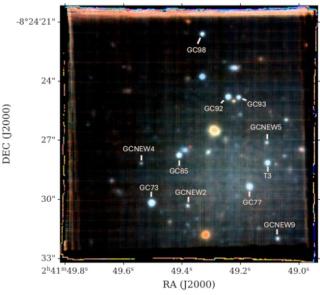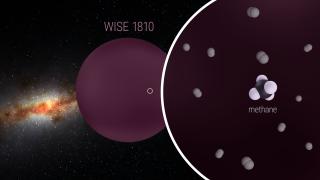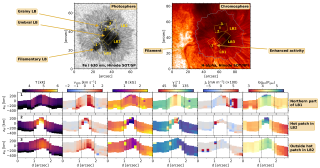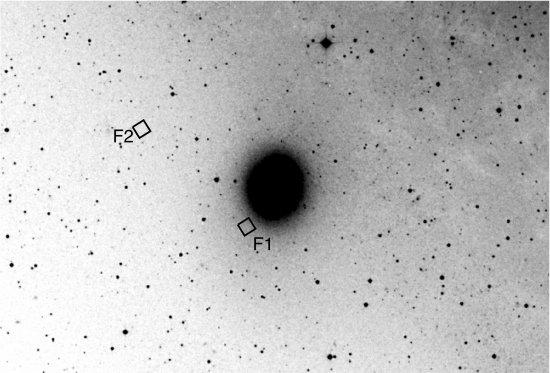We use deep Hubble Space Telescope Advanced Camera for Surveys/High Resolution Channel observations of a field within M32 (F1) and an M31 background field (F2) to determine the star formation history (SFH) of M32 from its resolved stellar population. We find that 2-5 Gyr old stars contribute ~40% ± 17% of M32's mass, while ~55% ± 21% of M32's mass comes from stars older than 5 Gyr. The SFH additionally indicates the presence of young (<2 Gyr old), metal-poor ([M/H] ~ –0.7) stars, suggesting that blue straggler stars contribute ~2% of the mass at F1; the remaining ~3% of the mass is in young metal-rich stars. The inferred SFH of the M31 background field F2 reveals that the majority of its stars are old, with ~95% of its mass already acquired 5-14 Gyr ago. It is composed of two dominant populations; ~30% ± 7.5% of its mass is in a 5-8 Gyr old population, and ~65% ± 9% of the mass is in an 8-14 Gyr old population. Our results suggest that the inner disk and spheroid populations of M31 are indistinguishable from those of the outer disk and spheroid. Assuming the mean age of M31's disk at F2 (~1 disk scale length) to be ~5-9 Gyr, our results agree with an inside-out disk formation scenario for M31's disk.
Advertised on
References
It may interest you
-
 O ne of the key challenges in astronomy is to measure accurate distances to celestial objects. Knowing distances is crucial since it allows us to measure physical properties such as size, mass and luminosity. Since we can’t go out and use a tape-measure, a range of different approaches have been developed. Many of these approaches rely on using “standard candles”. Standard candles are objects (for example stars or supernovae) for which we know their intrinsic ”true” brightness. Once we know this, then their observed brightness compared to their intrinsic brightness gives us a distance to theAdvertised on
O ne of the key challenges in astronomy is to measure accurate distances to celestial objects. Knowing distances is crucial since it allows us to measure physical properties such as size, mass and luminosity. Since we can’t go out and use a tape-measure, a range of different approaches have been developed. Many of these approaches rely on using “standard candles”. Standard candles are objects (for example stars or supernovae) for which we know their intrinsic ”true” brightness. Once we know this, then their observed brightness compared to their intrinsic brightness gives us a distance to theAdvertised on -
 WISEA J181006.18-101000.5 (WISE1810) is the nearest metal-poor ultracool dwarf to the Sun. It has a low effective temperature and has been classified as an extreme early-T subdwarf. However, methane--the characteristic molecule of the spectral class T--was not detected in the previous low-resolution spectrum. Constraining the metallicity--the abundance of elements heavier than helium-- of these cold objects has been a challenge. Using the 10.4 m Gran Telescopio Canarias, the largest optical-infrared telescope in the world, we collected a high-quality near-infrared intermediate-resolutionAdvertised on
WISEA J181006.18-101000.5 (WISE1810) is the nearest metal-poor ultracool dwarf to the Sun. It has a low effective temperature and has been classified as an extreme early-T subdwarf. However, methane--the characteristic molecule of the spectral class T--was not detected in the previous low-resolution spectrum. Constraining the metallicity--the abundance of elements heavier than helium-- of these cold objects has been a challenge. Using the 10.4 m Gran Telescopio Canarias, the largest optical-infrared telescope in the world, we collected a high-quality near-infrared intermediate-resolutionAdvertised on -
 Light bridges are elongated and bright structures protruding into the umbra of sunspots. The presence of light bridges has a significant role in the evolution of sunspots and the heating of their overlying atmosphere. Therefore, investigating these structures is crucial to understanding fundamental aspects of sunspots. By applying a novel code based on deep-learning algorithms called SICON to spectropolarimetric observations acquired with the Hinode satellite, we computed atmospheric parameters that allowed us to infer the variation of the physical properties of light bridges on a geometricAdvertised on
Light bridges are elongated and bright structures protruding into the umbra of sunspots. The presence of light bridges has a significant role in the evolution of sunspots and the heating of their overlying atmosphere. Therefore, investigating these structures is crucial to understanding fundamental aspects of sunspots. By applying a novel code based on deep-learning algorithms called SICON to spectropolarimetric observations acquired with the Hinode satellite, we computed atmospheric parameters that allowed us to infer the variation of the physical properties of light bridges on a geometricAdvertised on
